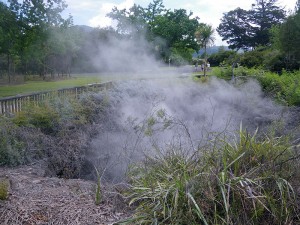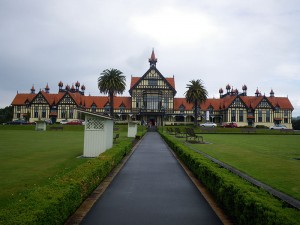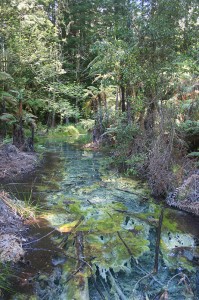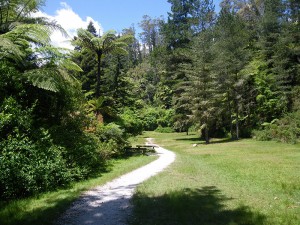After Auckland, our next stop was Rotorua. The town is built in the middle of an active volcanic area, and there are steam vents and boiling pools and mud pits dotted throughout town. A distinctive sulphur smell hangs in the air as well, and we learned from the manager of our hostel that when the smell gets particularly bad, the weather is likely to get bad also. Our hostel was situated next to Kuirau park, an expanse of green that featured rugby and cricket fields (except cricket fields are called pitches?), and also several pools of boiling water and mud, and with a few wading pools for the brave. Even the duck pond was still steaming in the heat of midday. Our hostel also had its own thermal pool, which was HOT! but very nice after our days spend walking and hiking.
Modern tourism in New Zealand began in the Rotorua region. In the 1870s, word got out about the hot springs and the Pink and White Terraces, mineral deposits on one end of nearby Lake Tarawera suitable for soaking, and Victorian travelers started venturing out to “take the waters.” Lodging started springing up, and local Maoris started hiring themselves out as guides, taking visitors to the terraces and other sites of interest to their culture and region. Sadly, in the mid-1880s, Mt. Tarawera erupted, wiping out the Terraces, raising the water levels in the lakes and killing about 150 people, a sizable portion of the population at that time. Tourism eventually rebounded, as it usually does, because although the Pink & White Terraces were gone, the hot springs were not, and a bath house was eventually built in the town that drew invalids, wounded soldiers, and those simply looking to relax. Some swore by the waters, claiming to be fully healed, while others viewed them as a distasteful, smelly almost-cure. Mud-baths, hot baths, even electric shock baths were on the menu for patients, and the old bath house, now unsuitable for a bathing as years of exposure to the hydrogen sulfide corroded all the pipes, is now the site of the excellent Rotorua Museum, and the old bath-rooms still remain.
Rotorua is also the activity center of the north island, or at least it tried to be. White water rafting, bungee jumping, sledging (running the river on a boogie board), kayaking the lakes and rivers, zorbing (rolling down the hill inside of a big ball), luging, erupting geysers and Maori hangi and dancing (something like a luau, we surmised). Rotorua has the nation’s largest percentage of Maori, and a lot of the activities center around Maori cultural tours. Maori have been living in the region and using the hot springs to cook their food and feasts since Polynesians first settled in New Zealand, so they have much history to share. A visit to either of the villages also included a look at the Pohutu geyser, New Zealand’s version of Old Faithful, along with several other geysers and thermal activity areas.
We found a place to hike close by, inside a grove of California redwoods planted by some entrepreneur in the early 1900s who apparently hoped to harvest them as timber, and to encourage more diversity of plant life? His first plan was realized, as a portion of the grove was closed while it was being harvested. We never found out whether the harvested sections were replanted with redwoods or not. it turned out to be more than redwoods, however, with other types of both native and imported trees, along with giant tree ferns and climbing vines and thick steam in a few places. After climbing a rise on one of the trails we followed that day, the forest opened up and gave us a view of the geyser and the villages around it, and the town of Rotorua with the lake beyond. It was an unexpected reward to the climb of an unexpected hill. If we’ve learned one thing about New Zealand, it’s that there’s very little flat ground, anywhere.
Rotorua is situated on the shores of Lake Rotorua, the largest lake in the region. A corner of the lake, Sulphur Bay, is highly acidic due to the volcanic activity in the area, but is also home to a few bird colonies.
Several rocky islands and islets in the bay are home to several types of gulls, cormorants and shags (New Zealand cormorant cousins), and some black swans. The acidity, however, also precludes any life in that area of the lake, so the birds have to fly to the other side of the lake to fish and forage. There’s a nice path around the lake, which was popular among joggers, and on our last day in Rotorua, we stumbled onto the finish line of a half-marathon that had apparently taken place that morning, on the lake’s edge. Some of the joggers were standing in the water (on the non-acidic side), soothing their sore muscles in the warm water. We, however, went to get ice cream at the popular shop on the corner (which also rents bikes), slurping to finish it before the Southern sun melted it all.





